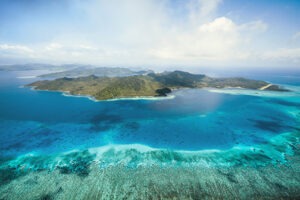
COMO Laucala Island in Fiji.
Travel writing has provided several amazing memories—but nothing like this particular trip a decade back. It was like flying into the Kingdom of Heaven, our private plane drifting quietly through layers of cloud made phosphorescent by the rising sun, the snowy cumulous puffs occasionally parting to reveal a tiny dot of either land or sea below. Only minutes earlier we’d been met after disembarking our 747 from Los Angeles, whisked through customs and a security checkpoint at Fiji’s Nadi International Airport, and aboard the turboprop Hawker 200 awaiting us on the tarmac for the 45-minute connection to COMO Laucala Island.
One of more than 800 islands and islets that comprise the Fijian archipelago, lying 5,100 kilometres southwest of Hawaii in the South Pacific and a three-hour flight from the Australia and New Zealand coasts, Laucala (pronounced Lauthala) is a resort unlike any on earth. Built as a private island retreat by Malcolm Forbes and acquired and upgraded in 2003 by Dietrich Mateschitz, CEO of the Red Bull drink company, the resort is set upon 3,200 spectacular acres that link mountain to beach. It became part of the COMO Hotels and Resorts portfolio in December 2021.
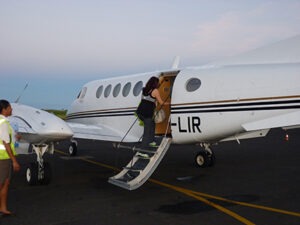
Mary boards the resort’s private jet from Fiji’s Nadi airport to Laucala Island.
Virtually self-sustaining, housing its own airplane hangars, medical clinic, sewage treatment plant, farms, gardens and even a separate marina for staff (most of whom arrive before sunrise from neighbouring Qamea Island), Laucala is essentially the ultimate all-inclusive for the über-rich—an eco-conscious Shangri-La that incorporates island-made products in the spa, native ingredients in its menu and a bevy of activities that celebrate its geography, from snorkelling and scuba diving among a forest of rare corals, to deep sea fishing and horseback riding.
Although we were running on fumes due to jetlag, a state of awe had already replenished our adrenaline tanks by the time the plane came to a rest and we were greeted by staff and native singers. From there it was a Jurassic Park-like route into the main complex to Plantation villa No. 2. Called Maqo (Mango), it’s one of just 25 residences on the island—each a collection of thatched-roofed, mahogany-floored pavilions constructed with timber beams and exquisite stonework, all occupying a 22-km walking trail threaded around the island. Our rotunda bathroom included a huge stone tub and an eight-foot alcove shower stall with a pair of showerheads. There were two more showers and another tub in the lush gardens outside. Enabling us to better take in that alluring view, each ocean-facing wall slid open, accordion-style, to fully expose the beach and our private infinity pool.
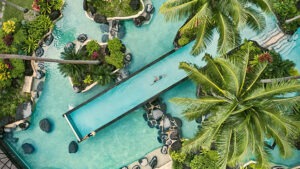
Looking down at the main pool complex.
Inside, our bar was stocked with a sterling assortment of wines, beers, liquors and softer beverages—customized to my personal preferences based upon an extensive questionnaire I received in advance of the trip. Even the tap water is as pure as it gets. Filtered by the island’s volcanic rock, it was also bottled in re-sealable glass containers throughout the resort—an essential accompaniment during the more humid summer months.
No detail was overlooked. Laundry was collected and returned folded the next morning. Flower-adorned cards were left bedside each evening with quotes from famous authors. Staff brought their maintenance vehicles to a halt whenever guests were within view. Tiny cakes and appetizers arrived mid-afternoon, just in case the all-inclusive array of five-star food and beverage somehow didn’t suffice.
And, seriously, you could come here simply for the epicurean delights, beginning with a menu rich in local fruits and vegetables at the elegant Plantation House. Even our morning eggs and the adorning herbs might well have been collected just hours earlier. But lunching in the 54,000-square-foot main pool complex, with skyscraping coconut palms bending overhead and a turquoise ocean beyond, hardly played second fiddle.
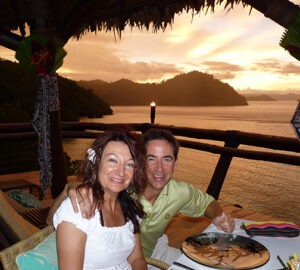
Mary and I at Seagrass restaurant, with a heavenly backdrop.
Then there was the indulgence of a private villa barbeque, where we were serenaded with traditional song as a huge bonfire blazed on the sand.
But nothing compared to the view from The Rock lounge, perched on a bluff overlooking the ocean. Nothing, that is, except for Seagrass Restaurant. Having your dinner cooked in front of you as waves thunder off the rocks below is dreamy stuff. The most sublime setting was the sunset view from Seagrass’s Lookout platform on our second-last night—a private table with a backdrop of a sky ablaze in hues of crimson, pink and orange, as the last rays of sun pierced wisps of cloud like ribbons through the heavens.
During our late-night return to our villa, watching closely not to squash frogs and crabs along the way in our private lighted golf cart, a sea of torches alerted us that bartender Joeli had kept the pool bar open, just in case the urge struck us. And so we stopped to share a bottle of champagne to celebrate an unforgettable night and day that had begun at the island’s crown jewel—its golf course.
It’s a breathtaking, unforgiving work from the hand of David McLay Kidd, whose award-winning golf architecture includes Bandon Dunes in Oregon, the Castle Course in St. Andrews, Scotland, and the exclusive Nanea in Hawaii. Although it’s a relentless test, the layout, unveiled in 2009, is infused with memorability and distinctive looks from every tee box. From the monster par-4 dogleg-left over a creek at No. 2, to the awe-inspiring drop into a valley at No. 4, to the beachside green complex at the 12th, McLay-Kidd made the most of the jaw-dropping terrain.
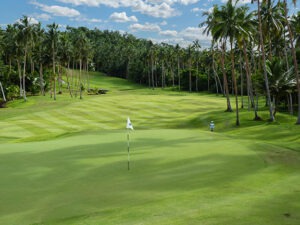
Mary walks to the 4th green at Laucala’s David McLay Kidd-designed golf course.
Guided by then-head professional Tony Christie, an affable and highly skilled Kiwi, I found myself plagued by a recurring block slice into the jungle on Day One. Searching for errant shots, though, was almost pointless—so dense was the underbrush. At least there are no dangerous native species, save for the odd falling coconut.
The theme continued during our next round, as I lost six balls in the first eight holes. But this time I had a legitimate excuse. In a land where romance is virtually unavoidable—call it “50 Shades of Green”—I proposed to the love of my life at the halfway lookout. Fortunately, she said yes.
Finding privacy to celebrate such an occasion was hardly an issue. The highest the occupancy rate had ever been in the resort’s four years of existence to that point was 14 villas of couples and families. But it was somewhat more exclusive for Mary and I. After an Austrian couple departed on the second morning, we were the only guests on the island—setting up an improbable staff ratio of 369-to-2. To be honest, though, there is so much to do and the staff so incredibly accommodating and enthusiastic that it never seemed awkward.
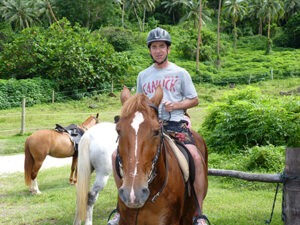
I enjoyed a little horseback riding—one of many activities at the resort.
The musical sendoff the final evening was, as expected, emotional. Mary’s sunglasses didn’t quite conceal the tears streaming down her cheeks. The handshakes and hugs at departure left us feeling as though we were departing close family, who thanked us for leaving a legacy—the island’s first engagement.
As the plane lifted into the evening sky, another sunset was painted onto the horizon—so striking that the pilot beckoned me forward with my camera. I snapped two shots. It was all that my five memory cards had left.
GETTING THERE
After you fly into Nadi International Airport, you’ll connect for a short flight on the resort’s own King Air B300 twin-engine turboprop with its eight leather seats.
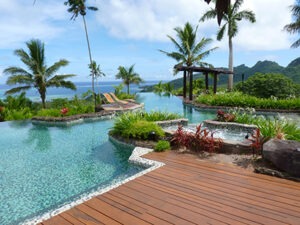
The pool complex at the Hilltop Villa.
CONTACTS & RATES
Laucala Resort
Web: Comohotels.com/fiji/como-laucala-island
Email: res.laucalaisland@comohotels.com
Phone: (011) 679-888-0077
Rates: $6,100 to $14,300 US per night plus taxes.
Golf fees: As with almost all activities on Laucala, golf is complimentary, as are the Titleist, Ping and Callaway rentals. I’d recommend bringing golf balls, as a dozen Titleist Pro V1’s go for $150 US. But if you can afford to stay here, that added cost won’t be a problem.
Island size: 12 sq. kms
Weather: Average daily highs hover from 25-30C, although it is more humid during their summer (our winter) months.
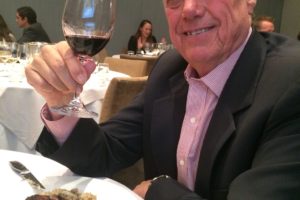
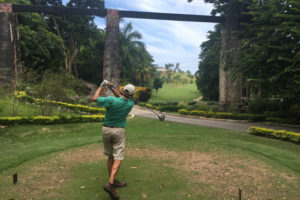
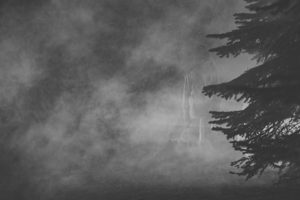
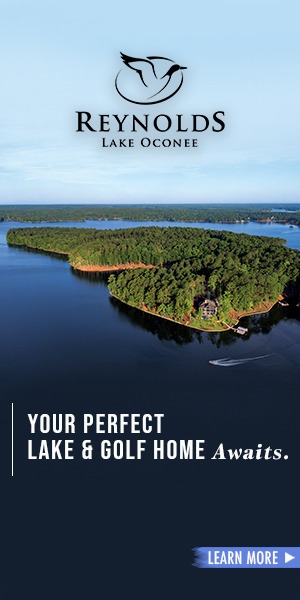
Leave a Reply
Your email is safe with us.